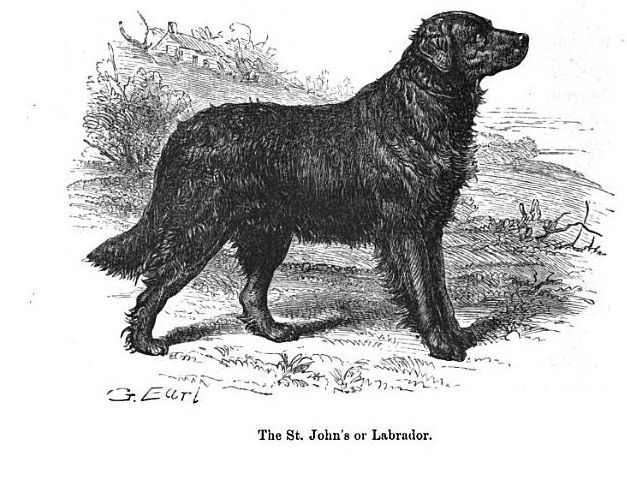The History Of The Labrador Retriever

The History Of The Labrador Retriever
With a strong, heavy built body and square proportions, the Labrador Retriever is classified as a working dog. One of their trademark characteristic features is a strong jaw set in a broad head. These dogs also have strong legs and shoulders, which add to their fast pace. At full adult size, they stand at about 21 to 24 inches in height at the withers (the highest part of the back), with a weight of 50 to 80 pounds. The coat is straight, dense, and short, with the outer coat being a bit coarse, and the undercoat thick and soft. This makes the Labrador all but completely waterproof, with the thick undercoat protecting the skin, and the outer guard coat whisking water away. Labradors have a certain distinct elegance, carrying themselves with an upright, proud demeanor, but with a friendly facial expression that invites new acquaintances and endears them to their human families.
The Labrador Retriever is generally categorized by lines that are destined for slightly different purposes. The show Labradors are bred for beauty and carriage -- for perfection in appearance, in other words. The hunting dogs follows the more traditional bloodlines, with usefulness being the key to perfection. The hunting Retriever has the physical characteristics that make it impervious to frigid water, an extraordinary sense of smell, and the agility to bag game with speed, along with companionable devotion to its human counterpart. Champion, or field trial Labradors, are bred for speed, energy, and intelligence, with appearance being the last consideration. Their appearance strays somewhat from the traditional Labrador -- they are quite trimmer, with smaller heads, and it is generally agreed that this line may be a bit too enthusiastic for the average dog owner. They require a much higher degree of exercise, and considerably more space to move around. Not least is the most popular category, the family Labrador.
Needless to say, this line is bred for intelligence, gentleness of temperament, tolerance, and a balance of energy with composure. They are as happy with a romp through the park as they are with a quiet evening at the hearth. No matter what differences in lines, all Labrador Retrievers are expected to maintain the characteristics that originally made them working dogs: stamina, energy, strength, and the ability to retrieve dependably, along with balanced structure and vitality.
The Labrador Retriever is found in black, chocolate, and yellow, with black being the most popular, and chocolate running a close second. The color of the nose should be the same as the color of the hair, with minimal fading. All other colors are the result of cross breeding and are not accepted as purebred Labrador Retrievers. The eyes should give the impression of intelligence and kindness; colors accepted for the eyes are brown for black and yellow haired Labs, and brown or hazel, for chocolate haired Labs.
The History of the Labrador Retriever is a little mysterious in so much that the Labrador Retriever does not originate from Labrador in Canada but rather from nearby Newfoundland.
Some theorists believe that the breed may even have originated in Portugal (Labrador means ‘labourer’ in Portuguese) before being introduced into Newfoundland by Portuguese sailors.
Whatever their origins the history of the Labrador Retriever began in the 19th century when the English aristocracy began to import the dogs from Newfoundland. Known as ‘St Johns’ dogs they would work with the Newfoundland fisherman retrieving lines and lost fish before going home to play with the children of the family. Labrador lovers of today will recognize their hard working, lovable and eager to please pet from in that description.
The St Johns Dogs were ideal for hunting and sport which was why they were so popular with well-to-do Englishmen who could afford to have them brought back from Canada. By the mid-1800s there were a few references to the St Johns Dogs being called Labradors though the name didn’t come into common use until around 1865.
By the 1880s a limited breeding programmed was underway in Britain. All Labradors were black until 1892 when the Duke of Buccleuch bred the first liver coloured Labs though the first real chocolate’s wouldn’t appear in any number until the 1930s. The first yellow Lab, the legendary Ben of Hyde, was born in 1899. I suppose the history of the Labrador Retriever officially began in 1903 when the breed was recognised by English Kennel Club with the American Kennel Club following suit in 1917.
Over in Newfoundland the St Johns Dog eventually became extinct after the introduction of sheep farming to the region. Legislation was passed towards the end of the 18th century limiting each family to only one dog and by the 1880s heavy licensing costs were imposed on the dogs with the taxes on females being higher than on males. The breed eventually died out in the 193s.
Earlier, the introduction of the Quarantine Act in Britain in 1895 more or less put a halt to the import of dogs and, with most of the true St Johns Dogs in England having died out, the Labrador breed was saved by a breeding programme undertaken by Dukes Buccleuch and Home along with the Earl of Malmesbury.
The history of the Labrador Retriever since the turn of the 20th century has being one of increasing popularity with the wonderful nature and characteristics of the breed making the Labrador one of the most well-liked and fashionable dogs for family pets as well as in showing and trialling circles.
Early Pictures From The History Of The Labrador Retriver

This is Nell, the photograph dating from 1856 and is the earliest ever photo of a Labrador (St Johns Dog).
Notice the white feet and muzzle.

This is the legendary Ben of Hyde.
Born in 1899 Ben was the first Yellow Labrador though the color of his coat could probably be described more accurately as 'Butterscotch'.